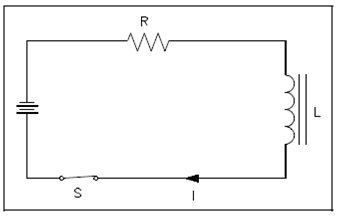Self-induced EMF:
Self-induced EMF is another phenomenon of induction. The circuit shown in Figure holds a coil of wire known as an inductor (L). As current flows by the circuit, a large magnetic field is set up around the coil. Because the current is not changing, there is no EMF produced. The field around the inductor collapses if we open the switch. This collapsing magnetic field generates a voltage within the coil. This is known as self-induced EMF.

Figure: Self-Induced EMF
The polarity of self-induced EMF is provided to us through Lenz's Law. The polarity is in the direction which opposes the modification in the magnetic field which induced the EMF. The result is in which the current caused through the induced EMF tends to manage the similar current which existed in the circuit before the switch was opened. It is generally said in which an inductor tends to oppose a change in current flow.
The counter EMF or induced EMF, is proportional to the time rate of change of the current. The proportionality constant is known as the "inductance" (L). An Inductance is a measure of an inductor's ability to induce CEMF. That is measured in henries (H). An inductor has an inductance of one henry if one amp per second modify in current generates one volt of CEMF, as display in Equation (3-1).
CEMF = -L (ΔI/Δt) (3-1)
where
CEMF = induced voltage (volts)
L = inductance (henries)
ΔI/Δt = time rate of change of current (amp/sec)
The minus sign displays in which the CEMF is opposite in polarity to the applied voltage.